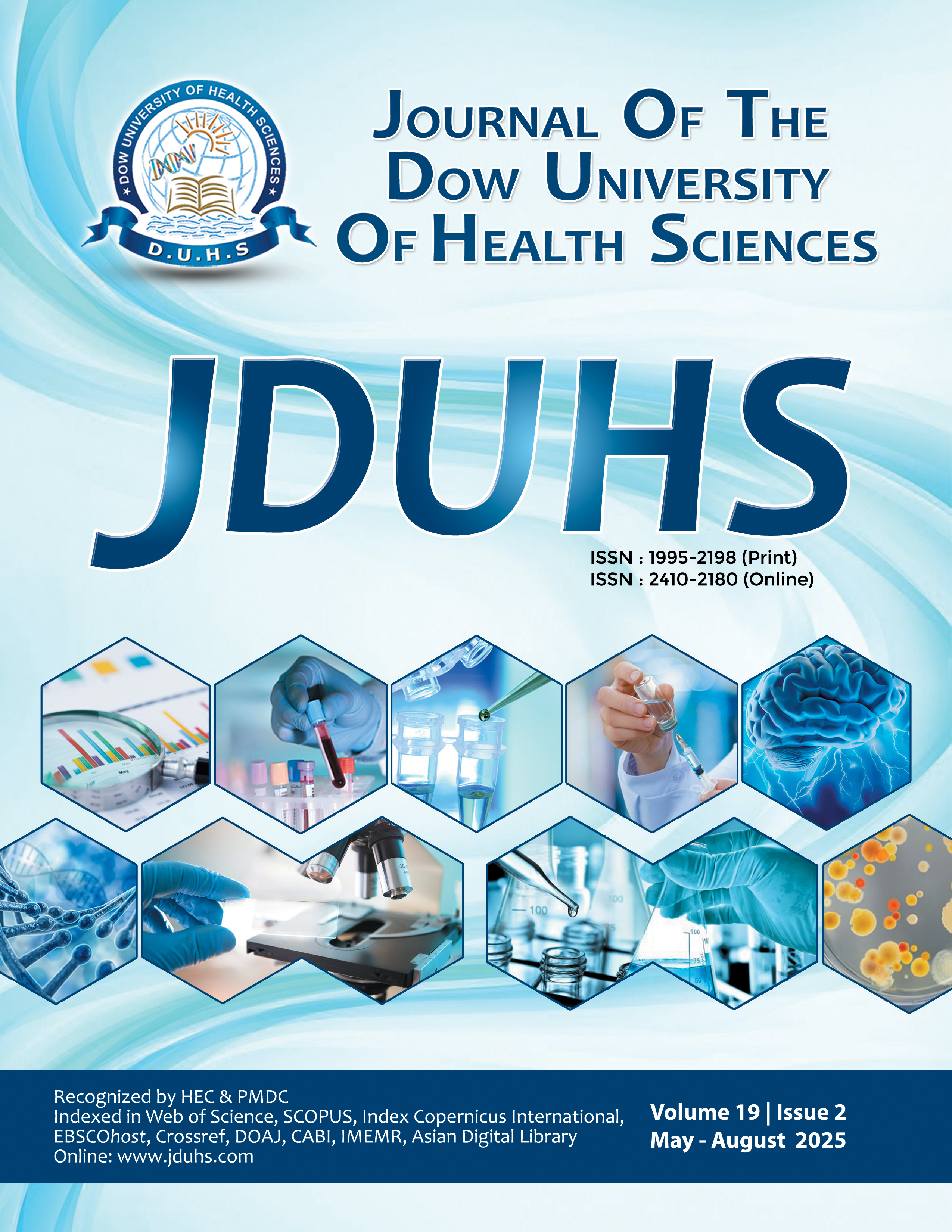Outcome of Laparoscopic versus Open Pyloromyotomy in Treatment of Infantile Hypertrophic Pyloric Stenosis
DOI:
https://doi.org/10.36570/jduhs.2025.2.2531Keywords:
Hypertrophic Pyloric Stenosis, Laparoscopy, Postoperative Pain, PyloromyotomyAbstract
Objective: To compare intraoperative and postoperative outcomes between laparoscopic and open pyloromyotomy in the treatment of infantile hypertrophic pyloric stenosis (IHPS).
Methods: This retrospective comparative study was conducted at the Department of Pediatric Surgery, Leeds General Infirmary, United Kingdom from May 2023 to April 2025. Infants aged from birth to 3 months with a confirmed diagnosis of infantile hypertrophic pyloric stenosis were included and grouped based on the surgical approach: laparoscopic or open pyloromyotomy. Primary outcomes included operative time, postoperative pain (assessed using the visual analogue scale), time to full feeding, complications and re-do surgery.
Results: A total of 61 infants with infantile hypertrophic pyloric stenosis, with 30 undergoing laparoscopic and 31 undergoing open pyloromyotomy. The median age at surgery and weight were 38.0 days (31.0–49.0) and 3.8 kg (3.3–4.1). The median operative time was insignificantly longer in the laparoscopic group 70.0 minutes (51.2-86.2) compared to the open group 64.0 minutes (49.0-70.0) (p-value = 0.225). However, the median postoperative pain score was significantly lower in the laparoscopic group compared to the open group i.e., 3.0 (3.0-4.0) vs. 5.0 (5.0-6.0) (p-value < 0.001). Time to full feeding was 24.0 hours in both groups, and the median length of hospital stay was 3.0 days. Re-do pyloromyotomy was required in 2 patients (6.7%) in the laparoscopic, while no re-do operations were needed in the open group.
Conclusion: Laparoscopic pyloromyotomy is associated with lower postoperative pain compared to open pyloromyotomy, with slightly longer operative time but similar time to full feeding and hospital stay.
Downloads
References
Galea R, Said E. Infantile Hypertrophic Pyloric Stenosis: An Epidemiological Review. Neonatal Netw 2018; 37:197-204. doi:10.1891/0730-0832.37.4.197
Abdellatif M, Ghozy S, Kamel MG, Elawady SS, Ghorab MME, Attia AW, et al. Association between exposure to macrolides and the development of infantile hypertrophic pyloric stenosis: a systematic review and meta-analysis. Eur J Pediatr 2019; 178:301-14. doi: 10.1007/s00431-018-3287-7
Rosenthal YS, Chodick G, Grossman Z, Shalev V, Koren G. The incidence of infantile hypertrophic pyloric stenosis and its association with folic acid supplementation during pregnancy: A nested case-control study. J Pediatr Surg 2019; 54:701-6. doi:10.1016/j.jpedsurg.2018.05.005
Kaye P. Acquired pyloric stenosis resulting in hypokalaemic, hyperchloraemic normal anion gap metabolic acidosis. Persistent vomiting in an adult: cause and effect. BMJ Case Rep 2018; 2018: bcr2017222800 doi:10.1136/bcr-2017-222800.
Baskovic M, Zupancic B, Lesjak N, Vukasovic I. Hypertrophic Pyloric Stenosis - Five-Year Retrospective Analysis. Acta Med Croatica 2016; 70:103-6.
Adibe OO, Nichol PF, Flake AW, Mattei P. Comparison of outcomes after laparoscopic and open pyloromyotomy at a high-volume pediatric teaching hospital. J Pediatr Surg 2006; 41:1676-8. doi:10.1016/j.jpedsurg.2006.05.051
Mork K, Skari H, Schistad O, Nas PA. [Surgical treatment of pyloric stenosis]. Tidsskr Nor Laegeforen 2018; 138. doi:10.4045/tidsskr.17.0619
Kawahara H, Takama Y, Yoshida H, Nakai H, Okuyama H, Kubota A, et al. Medical treatment of infantile hypertrophic pyloric stenosis: should we always slice the "olive"? J Pediatr Surg 2005; 40:1848-51. doi:10.1016/j.jpedsurg.2005.08.025
Ismail I, Elsherbini R, Elsaied A, Aly K and Sheir H. Laparoscopic vs. open pyloromyotomy in treatment of infantile hypertrophic pyloric stenosis. front. Pediatr 2020; 8:426. doi:10.3389/fped.2020.00426
Greason KL, Allshouse MJ, Thompson WR, Rappold JF, Downey EC. A prospective, randomized evaluation of laparoscopic versus open pyloromyotomy. Pediatr Endosurg Innov Tech 1997; 1:175-9. doi:10.1089/pei.1997.1.175
Downey EC. Laparoscopic pyloromyotomy. Semin Pedi-atr Surg 1998; 7:220-4. doi:10.1016/S1055-8586(98)70034-4
Costanzo CM, Vinocur C, BermanL. Postoperative outcomes of open versus laparoscopic pyloromyo-tomy. J Surg Res 2018; 224:240-4. doi:10.1016/j.jss.2017.08.040
Qassem MG, Dahish AH, Soliman MH, Matar M. Open versus laparoscopic pyloromyotomy for infantile hypertrophic pyloric stenosis. Ain Shams J Surg 2024; 17:29-39.
Lunger F, Staerkle R, Muf J, Fink L, Holland-Cunz S, Vuile- Dit-Bille R. Open versus laparoscopic pyloromyotomy for pyloric stenosis: a systematic review and meta-analysis. J Surg Res 2022; 274:1-8. doi:10.1016/j.jss.2021.12.042
He L, Li S, Tang X. Open versus laparoscopic pyloromyo-tomy for infantile hypertrophic pyloric stenosis: A systematic review and meta-analysis. Int J Clin Exp Med 2022; 15:129-35.
Gilna G, Saberi R, Huerta CT, O'Neil CF, Ramsey WA, Parreco J, et al. Laparoscopic versus open pyloromyotomies: outcomes and disparities in pyloric stenosis. J Pediatr Surg 2022; 57:1051-6. doi:10.1016/j.jpedsurg.2021.12.041
Leonhardt J, Muensterer O, Alsweed A, Schmedding A. Nationwide trends of laparoscopic pyloromyotomy in patients with infantile hypertrophic pyloric stenosis in Germany: A slow path forward. Front Pediatr 2023; 11:1149355. doi:10.3389/fped.2023.1149355
Ramji J, Joshi RS. Laparoscopic pyloromyotomy for congenital hypertrophic pyloric stenosis: Our experience with twenty cases. Afr J Paediatr Surg 2021; 18:14-7. doi:10.4103/ajps.AJPS_119_20
Camporesi A, Diotto V, Zoia E, Rotta S, Tarantino F, Echer LM, et al. Postoperative apnea after pyloromyotomy for infantile hypertrophic pyloric stenosis. World J Pediatr Surg 2022; 5:e000391. doi:10.1136/wjps-2021-000391
Bunder FA, Wijk L, Woensel JB, Stevens MF, Heurn LW, Derikx JP. Perioperative apnea in infants with hypertrophic pyloric stenosis: A systematic review. Paediatr Anaesth 2020; 30:749-58. doi:10.1111/pan.13879
Published
How to Cite
Issue
Section
License
Copyright (c) 2025 Mushkbar Naeem

This work is licensed under a Creative Commons Attribution-NonCommercial 4.0 International License.
Articles published in the Journal of Dow University of Health Sciences are distributed under the terms of the Creative Commons Attribution Non-Commercial License https://creativecommons.org/ licenses/by-nc/4.0/. This license permits use, distribution and reproduction in any medium; provided the original work is properly cited and initial publication in this journal. ![]()





